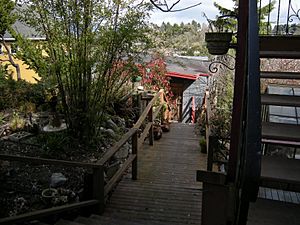James W. Washington Jr. facts for kids
James W. Washington Jr. (born November 10, 1908 – died June 7, 2000) was an American painter and sculptor. He became a very important artist in the Seattle art world.
James Washington Jr. was born and grew up in Gloster, Mississippi. This was a small town in the Jim Crow South, where laws kept Black and white people separate and unequal. He was one of six children. His father, a Baptist minister, had to leave when James was young because of threats of violence. They never saw each other again.
James started drawing when he was 12 years old. At 14, he began learning to be a shoemaker. He also worked many different jobs, including one that let him travel to bigger towns. When he was 17, he got his first job with the government. He worked for the government off and on until he was almost 60.
In 1938, he joined the Federal Works Progress Administration (WPA). This was a government program that helped people find jobs during the Great Depression. He worked as an assistant art teacher in Mississippi. Because Black artists were not allowed to show their art with white artists in the South, James created the first WPA art show for Black artists in Mississippi.
In 1941, James moved to Little Rock, Arkansas, where his mother lived. He repaired shoes at a military camp there. This government job soon took him to the Pacific Northwest. He and his wife, Janie Rogella Washington, arrived in Seattle in 1944. Seattle became their home for the rest of their lives. James first did electrical work on warships at a naval base. Then, he moved to Fort Lawton in Seattle, where he ran a shoe shop.
Contents
Becoming Part of the Seattle Art Scene
James quickly became involved in Seattle's small art community. He showed his art at a department store gallery. He also studied with famous artist Mark Tobey. Tobey mostly encouraged James rather than teaching him specific techniques.
From 1948 to 1961, James organized art shows at Seattle's Mount Zion Baptist Church. Many artists showed their work there, including Kenneth Callahan, who was a curator at the Seattle Art Museum. After studying with Tobey, James Washington's art began to show traits of the Northwest School (art). This art style shared features with the work of Tobey and Morris Graves.
James also met other artists like Fay Chong, Andrew Chinn, Kenjiro Nomura, John Matsudaira, and George Tsutakawa. He also took art classes at the University of Washington.
James and his wife lived in Seattle's Central District. He had his art studio in his home. From 1950, he was a member of Artists Equity Seattle, a group for artists. He served as its secretary for ten years and later as its president.
In 1951, James traveled to Mexico. There, he met famous mural painters Diego Rivera and David Alfaro Siqueiros. In Mexico, he also discovered soft volcanic rock. This stone soon led him to focus on sculpture. Before this, he had mostly carved wood. His first stone sculpture, Young Boy of Athens, was made from a stone he found at Teotihuacán, an ancient city in Mexico.
James Washington Jr.'s Artworks
James Washington Jr. was skilled in both painting and sculpture. Some of his paintings also included collage, which means adding different materials like newspaper clippings to the artwork. Many of his paintings showed buildings from his life or scenes from his travels.
Art About Important Issues
Some of his artworks directly addressed racism. For example, his 1945 painting The Making of the UN Charter used newspaper clippings and images of body parts. This painting showed that Black people fought and died for freedom in World War II, but were still not treated equally in their own country, even with new human rights declarations.
Another powerful piece was his 1946 sculpture The Chaotic Half. It showed a Black hand reaching for a ballot box, next to symbols like a hooded Klansman, a crucifix, and a noose. These symbols highlighted the struggles for voting rights and the violence faced by Black people.
James often focused on African and African-American subjects in his art. In 1962, he created a sandstone sculpture of Jomo Kenyatta, a leader from Kenya. In 1969, he was asked to create six granite sculptures of famous African Americans for a "Rotunda of Achievement" in Philadelphia. His art also included many references to Freemasonry and stories from the Bible. He was a high-ranking member of the Masons.
Art and Spirituality
James Washington Jr. believed his art was a spiritual journey. He once said, "To me, art is a holy land." When sculpting an animal, he explained, "I wait until intuition moves me... I get to the point where I am the animal... I release the spiritual force into the inanimate material and animate it." He felt like he was working with living flesh, not just stone.
Some of his religious artworks include paintings from 1952, like The Passover (a version of the Last Supper), a Nativity Scene, and an encaustic (a painting made with heated wax) of Christ in the Garden of Gethsemane. One of his sculptures from the mid-1950s is called Head of Job.
Once James became known as a sculptor, he preferred to work with granite. Experts have compared his early sculptures to ancient Mediterranean art. Their simple and powerful look also fits with modern sculpture styles.
James Washington Jr.'s House and Studio
Since 1992, James Washington Jr.'s house and studio at 1816 26th Avenue in Seattle have been recognized as an official city landmark.


